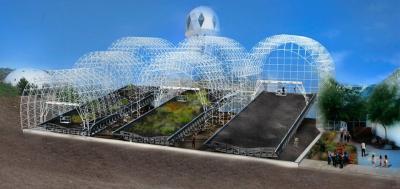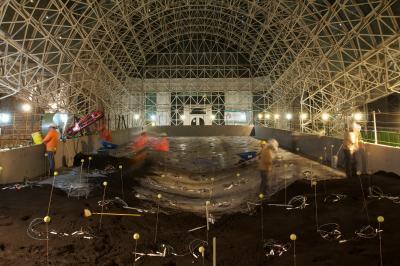Rain in Southern Arizona is usually scarce - but on November 29th, 25 miles north of Tucson, the soil was soaked. Spouting from a network of pipes, thousands of gallons of water drizzled down onto the world's only and largest man-made experimental watershed, recently completed at the University of Arizona's Biosphere 2. You can read articles from original Biosphere 2 scientist Jane Poynter here.
Six-hundred tons of ground-up volcanic rocks blanket a giant steel tub resting at an incline to form an artificial hill slope. Three identical such hill slopes, each measuring 100 feet long and 40 feet wide, were constructed side by side to form the Landscape Evolution Observatory, or LEO, with the first now fully functional.
Each slope is studded with a network of more than 1,800 sensors and samplers sensing and tracking the flow of water through the soil and drawing samples for analysis.
"It's the first time anyone has built an instrument like that," said Biosphere 2 Science Director Peter Troch, a professor in the UA's department of hydrology and water resources. "LEO provides the scientific community with a tool to learn about the landscape in ways we haven't been able to before. It will help us to really understand Earth's surface processes."
"The interactions of water and organisms living in and on the ground are what sustains life on Earth," Troch added, explaining that minerals in the soil release nutrients, which are then transported in water and changed by microbes until plants extract them and turn them into biomass.
"We don't know much about those processes," he said. "Geochemists study how minerals weather, ecologists study how plants use water, hydrologists study how water moves through a landscape, but nobody has brought all this together. That's what LEO does."
Housed inside Biosphere 2's greenhouse dome, LEO provides researchers with real evidence of how the changing climate will affect movement of water and how the atmosphere interacts with the soil, for example. Most importantly, the observatory allows scientists to tinker with various environmental conditions and study the outcomes in a reliable fashion, something that is impossible to do in the natural world. After all, it is not possible to turn off the rain in the Amazon basin for a month and see what happens to the rainforest in an increasingly drier climate. But the enclosed and controlled environments of Biosphere 2 make just these kinds of experiments possible.

Once completed, three hillslopes side by side will make up the Landscape Evolution Observatory. Credit: UA College of Architecture and Landscape Architecture
"We can change the climate to drier or more extreme conditions and see how well the predictions based on our computer models hold up," Troch said. "For example, we may predict that the Sonoran Desert ecosystem may turn into shrub or grassland, but those are just predictions. LEO can help validate those predictions."
Observations made with LEO will reach far beyond the arid Southwest, Troch said. The results that will come out of the 10-year project will be used to improve global climate models and make the predictions made by simulations more realistic and reliable.
In parallel with building LEO, UA scientists have been developing a computer model combining hydrology, biogeochemistry, ecology and other fields.
"Nobody has ever taken the effort to put all that into one model," Troch said. "But in a landscape, everything is connected. Water flows through the landscape, bacteria metabolize the nutrients in the soil, the plants then take up those nutrients and feedback into the atmosphere. All those processes happen simultaneously."
Building the observatory was like assembling and rigging three ships in a bottle, said Stephen DeLong, an assistant research professor at Biosphere 2 with a joint appointment in the department of geosciences. Everything needed to build the three hillslopes had to come through a 10-by-10-foot opening.
"Almost every aspect of the project had to be figured out from scratch," DeLong said. "We worked very closely with the design and engineering firm and the steel contractors to find engineering solutions that would achieve our scientific goals, for example how to integrate the soil sensors and make sure they work reliably for years to come."
Troch said LEO was a great challenge from an engineering point of view because it had to be built as a balancing scale with a 10-degree slant.

LEO's hillslopes had to be built like ships in a bottle: All the parts came through an opening measuring only 10 by 10 feet. Credit: UA Biosphere 2
The steel construction supporting each slope and the soil on top weigh about 650 tons, more than a fully loaded Jumbo Jet. Specially developed steel cylinders acting as structural support and balancing scales keep track of the weight changes brought about by water raining on and evaporating from the soil as the slope evolves into a living and breathing hillside.
Its size and sloping angle are key to LEO's capabilities, Troch explained.
"Landscapes are rarely completely flat," he said. "As soon as you have a slope, water infiltrates and hits the bedrock and moves downhill under gravity."
"Imagine a tree sitting on top of a hill slope. When it rains, the water runs down the slope, and for that tree, it is gone very quickly. That plant has to develop strategies to use that water efficiently, especially in a dry landscape. The trees further down receive water not just from rain, but also from what comes running down the slope. The further down you go, the more water becomes available. And with the water move the nutrients."
"Scientists are still figuring out how much water a tree actually uses," Troch said, "and if I only measure in one tree or one patch of soil, I have no idea how much the entire slope is transpiring because there is no comparison."
"LEO gives us this comparison at a scale that is relevant for landscapes," he said. "The data go into a database, where everybody can access them and use them to validate their own models."
The project scientists expect LEO to spark many collaborations among researchers from across the globe and bring together diverse disciplines that traditionally have not pooled their expertise to solve complex problems.
"This is important to the public because of the challenges we face on a global level," DeLong said. "What happens to landscapes after droughts occur and conditions become drier in general? How do increased dryness and heat affect fire danger and, down the road, people?"
Over the next 10 years, LEO will undergo constant evolution. While the instrumentation on the two other slopes is being completed, scientists have their hands full collecting data and calibrating sensors with the bare soil and the occasional downpour.
"We know there are microbes in the soil, and they will start taking gases from the atmosphere and turning them into compounds that they give off into the soil and help with chemical weathering," Troch said, "and we can study those processes right away."
DeLong expects the first plants to be added in a year or two.
"Slowly and surely we'll add vascular plants, like grasses, shrubs and mesquite trees, to see how the hydrology changes when you add vegetation," he said. "But we really want to understand the system as much as possible before plants make it more complicated."

A network of sensors track every move of water flowing down the artificial watershed, as well as gas exchange and chemical processes in the interplay among soil, atmosphere, plants and microbes. Credit: UA Biosphere 2




Comments